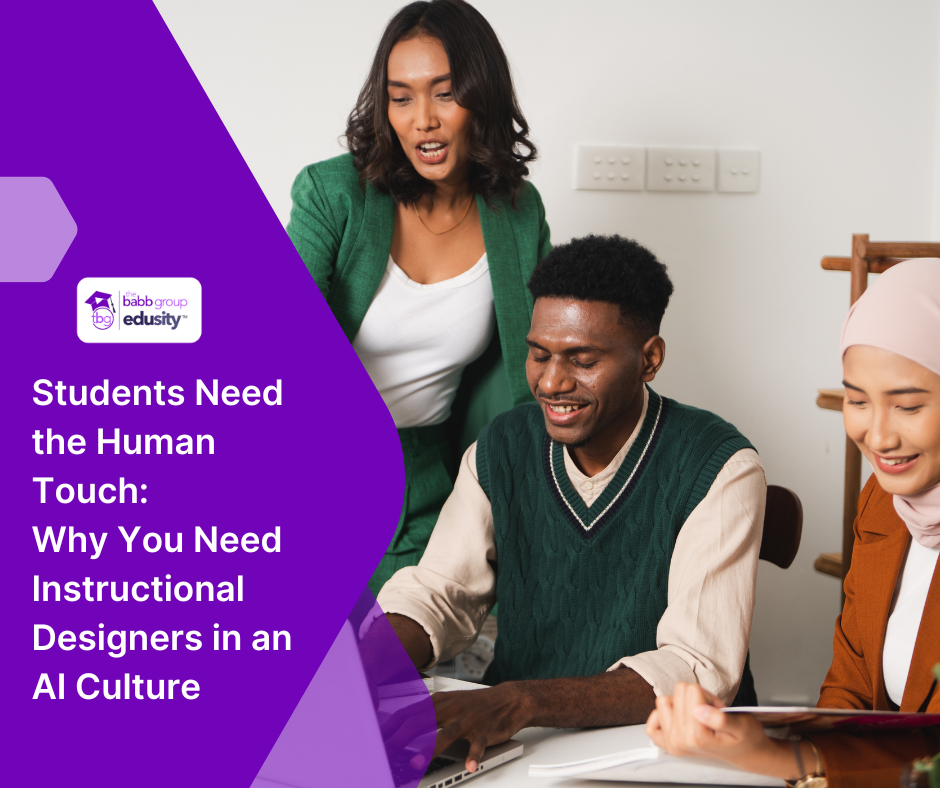
Understanding Learner Needs
One of the most significant advantages of human instructional designers is their ability to comprehend the unique needs of individual learners. Every student has their own learning style, pace, and challenges. Human designers have the empathy and experience to tailor courses accordingly, considering factors such as cultural background, language proficiency, and accessibility requirements. Personalized instruction can significantly enhance the learning experience and promote student success.
Collaboration
Creating a course is rarely a solo project. SMEs, faculty, and instructional designers often collaborate to develop the best product for students. Faculty and SMEs bring their research, industry, and teaching experience to course development. Instructional designers deliver best practices for engagement, accessibility, course navigation, assessments, media, and resources. When teams collaborate to create courses with the goal of students demonstrating they mastered the learning outcomes, everyone succeeds.
Creating Simulations, Scenarios, and Class Discussions
Effective learning goes beyond merely transmitting information; it involves engagement and active participation. Human instructional designers can create dynamic simulations and scenarios that simulate real-world situations, allowing learners to apply their knowledge in practical settings. Creating engaging discussions where students want to actively participate, share relevant personal experiences, and are encouraged to have thoughtful exchanges with classmates demand the experience of an instructional designer or faculty member who gets what it is to facilitate an online discussion board. Active discussion boards can foster collaborative learning environments, exchange of perspectives, and deepen empathy for classmates.
You might also like Course Maintenance: Updates for Engagement, Accessibility, and Quality.
Alignment with Institutional Goals and Course Objectives
Instructional designers play a pivotal role in bridging the gap between the overarching goals of an institution or program and the specific learning outcomes of a course. It’s more than creating a map in a document that shows how objectives and goals are related. Expertise in curriculum design enables instructional designers to develop course content, assessments, and activities that meet the needs of individual learners and contribute to the overall mission and vision of the educational institution.
Mastering Competencies and Real-World Applications
Need more tips on AI, course design, and higher ed trends? Sign up for our monthly newsletter.
Leveraging Industry Knowledge and Expertise
Human instructional designers bring invaluable expertise to the table. They possess a wealth of knowledge about the subject matter, industry trends, and the latest advancements. This knowledge enables them to craft timely, relevant, and practical courses. Instructors with hands-on experience in their respective fields can impart insights and wisdom that an AI lacks, making the learning experience richer and more meaningful.
While AI and technology undoubtedly offer exciting possibilities for education, instructional designers are the cornerstone of creating compelling and engaging online courses for diverse learners. Real people understand the intricacies of individual needs, design interactive simulations and discussions, align courses with institutional goals, promote real-world applications, and bring industry knowledge to the instructional design process. As education continues to evolve, it is essential to recognize the irreplaceable value of the human touch in shaping the future of online learning. Let us celebrate the expertise of instructional designers and leverage their skills to unlock the full potential of every learner.
Angela Britcher
Latest posts by Angela Britcher (see all)
- Enhancing First-Year Experiences in Higher Education - August 1, 2024
- Enhancing Education with Virtual Reality: A Hands-On Approach - June 27, 2024
- Higher Education Trends: Insights from Our COO, Sheila Fry - June 13, 2024
